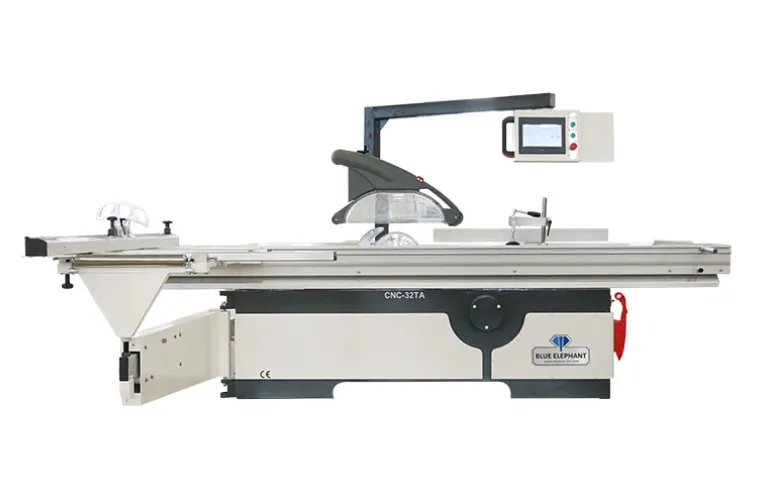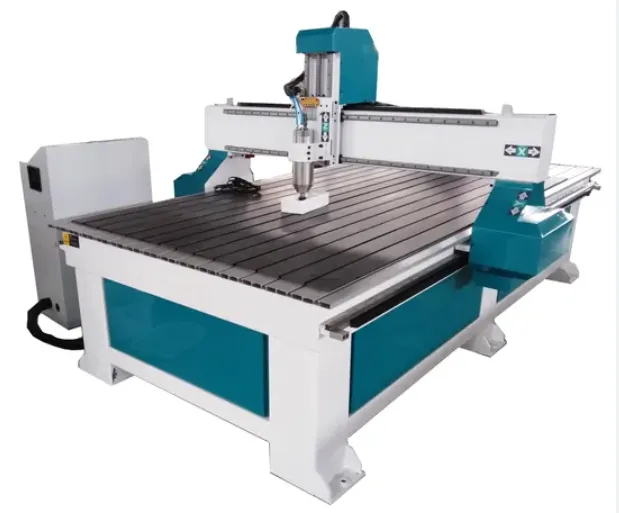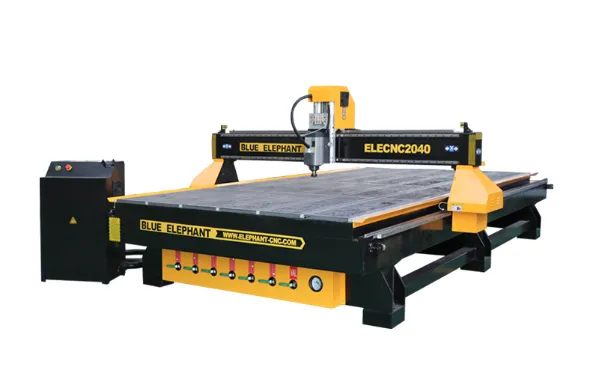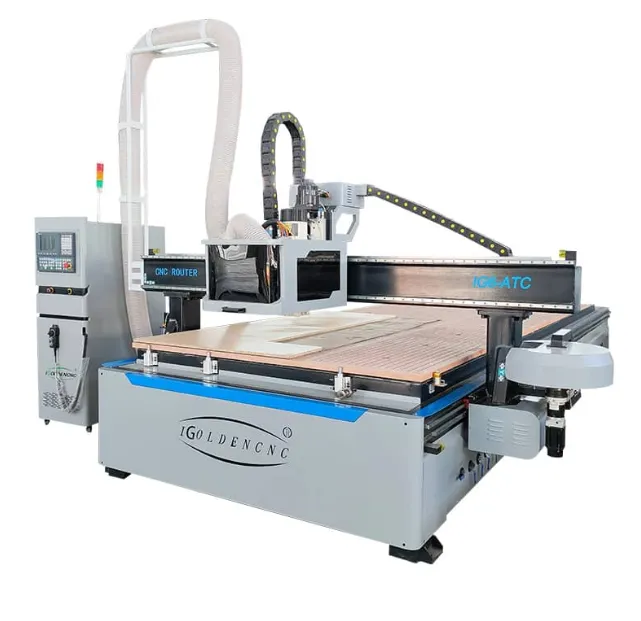Machine Architecture and Structural Components
CNC wood cutting machines feature a rigid gantry-style frame constructed from welded steel or aluminum extrusions. The base platform typically consists of a vacuum table or T-slot bed measuring 1.2m x 2.4m to 2.5m x 5m for industrial models. Heavy-duty linear guide rails with recirculating ball bearings support the moving gantry, which houses the spindle carriage system. The Z-axis assembly incorporates a counterbalance mechanism to maintain positional stability during vertical movements. Motion Control System
Motion Control System
These machines employ:
- Stepper or servo motor drives (400W-7.5kW)
- Rack-and-pinion or ball screw drive mechanisms
- High-resolution encoders (minimum 1000 counts/rev)
- Anti-backlash compensation systems
- Maximum travel speeds of 30-100m/min
- Positioning accuracy within ±0.05mm/m
- Repeatability of ±0.02mm across all axes
Cutting Spindle Specifications
Standard spindle configurations include:
- Air-cooled routers (1.5-15kW)
- Liquid-cooled spindles (3-30kW)
- Speed ranges from 6,000-24,000 RPM
- ER collet tool holding systems (ER20-ER40)
- Automatic tool changers (optional)
- HSK tool interface for high-performance models
- Integrated dust collection ports
Control System and Software
The CNC system comprises:
- Industrial PC with dedicated motion controller
- Touchscreen HMI (15″-24″ displays)
- USB/Ethernet connectivity
- Offline programming capability
- Standard G-code compatibility
- Proprietary woodworking software packages
- 3D simulation and verification
- Network monitoring options
Tooling and Cutting Technology
Common cutting tools include:
- Compression spiral bits (6-25mm diameter)
- Straight flute cutters
- V-groove tools
- T-slot cutters
- Ball nose end mills
- Specialized panel processing tools
- Diamond-tipped tools for abrasive materials
Material Handling Systems
Workpiece management features:
- Vacuum hold-down (zoning capability)
- Mechanical clamping systems
- Automatic sheet loaders (optional)
- Conveyor belt systems (for production lines)
- Rotary axis attachments (4th axis)
- Nesting optimization software
Cutting Process Parameters
Typical operating ranges:
- Feed rates: 5-30m/min
- Plunge rates: 1-5m/min
- Depth of cut: 1-30mm per pass
- Chip load: 0.1-0.5mm/tooth
- Tool life: 50-200 hours (depending on material)
Dust Collection and Safety
Integrated environmental systems:
- 150-300mm diameter dust ports
- 5,000-15,000 CFM extraction capacity
- Fire suppression options
- Spark detection systems
- Emergency stop circuits
- Light curtain protection
- Noise reduction enclosures
Material Compatibility
Designed to process:
- Solid wood (soft/hardwoods)
- Engineered wood products (MDF, plywood)
- Composite panels (HDF, particleboard)
- Plastic sheets (acrylic, PVC)
- Aluminum composite materials
- Foam and insulation boards
Software Ecosystem
Specialized woodworking software provides:
- CAD/CAM integration
- Nesting optimization
- Toolpath simulation
- Grain direction analysis
- Batch processing
- Cut list generation
- DXF/DWG compatibility
Production Applications
Common manufacturing uses:
- Cabinet and furniture production
- Door and window manufacturing
- Sign making and engraving
- Musical instrument components
- Architectural millwork
- Exhibition and display fabrication
- Wooden toy production
Machine Configurations
Available variants include:
- 3-axis standard models
- 5-axis contouring machines
- CNC routers with drilling units
- Beam saws with CNC control
- Panel processing centers
- Point-to-point machines
Precision Specifications
Manufacturer performance standards:
- Positioning accuracy: ±0.05mm
- Repeatability: ±0.02mm
- Surface finish quality: Ra 3.2-6.3μm
- Angular accuracy: ±0.1 degrees
- Straightness: 0.05mm/m
Electrical Requirements
Typical power needs:
- Main spindle: 3-30kW
- Servo drives: 1-5kW each
- Vacuum system: 3-15kW
- Control system: 500W-1.5kW
- Auxiliaries: 1-3kW
- 3-phase 380-480V power supply
Maintenance Protocols
Recommended service schedule:
- Daily lubrication of guide rails
- Weekly vacuum pump checks
- Monthly spindle bearing inspection
- Quarterly ball screw maintenance
- Annual electrical system testing
- 2,000-hour spindle service
Optional Features
Available upgrades include:
- Automatic tool measurement
- Laser positioning systems
- Camera registration
- Barcode scanning
- Label printing
- Robotic loading/unloading
Economic Considerations
Production factors:
- Throughput: 50-500 sheets/day
- Material utilization: 85-98%
- Labor requirements: 1-2 operators
- Energy consumption: 10-50kWh
- Maintenance costs: 2-5% of capital/year
Safety Systems
Comprehensive protection includes:
- Emergency stop buttons
- Overload protection
- Thermal monitoring
- Tool break detection
- Fire suppression
- Dust explosion prevention
Industry Standards Compliance
Machines meet:
- CE safety directives
- UL electrical standards
- ISO 19085 woodworking norms
- Local noise regulations
- Dust emission standards
Technological Advancements
Recent innovations feature:
- AI-based tool wear prediction
- Cloud-based monitoring
- Augmented reality setup
- Hybrid additive/subtractive
- Energy recovery systems
Operator Interface
Control panel characteristics:
- Multi-touch displays
- On-screen keyboard
- Job queuing system
- Production statistics
- Alarm history
- Maintenance reminders
Quality Control Systems
Integrated inspection methods:
- Tool length measurement
- Material thickness sensing
- Cut quality monitoring
- Production documentation
- Barcode tracking
Physical Dimensions
Typical machine sizes:
- Benchtop models: 1.5x1m footprint
- Production machines: 3x6m area
- Custom large-format: up to 8x20m
- Weight ranges from 500kg to 20,000kg
Future Development Trends
Emerging technologies:
- Increased automation
- Improved dust extraction
- Enhanced software integration
- More compact designs
- Multi-function capabilities
- Sustainable manufacturing








